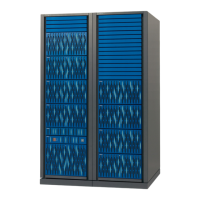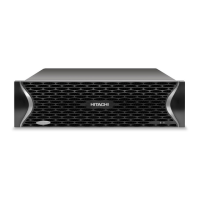xxxxx = the port name/number of horcm0.conf
horcm1 xxxxx/udp
xxxxx = the port name/number of horcm1.conf
2. If you want CCI to start automatically each time the system starts up,
add \HORCM\etc\horcmstart 0 1 to the system automatic startup file
(for example, \autoexec.bat).
3. Execute the horcmstart script manually to start CCI: D:\HORCM\etc>
horcmstart 0 1
4. Set an instance number to the command execution environment: D:
\HORCM\etc> set HORCMINST=X
X = instance number = 0 or 1
5. Set the log directory (HORCC_LOG) in the command execution
environment as needed.
6. If you want to perform TrueCopy operations, do not set the
HORCC_MRCF environment variable. If you want to perform
ShadowImage operations, set the HORCC_MRCF environment variable
for the CCI execution environment:
D:\HORCM\etc> set HORCC_MRCF=1 D:\HORCM\etc> pairdisplay
-g xxxx
xxxx = group name
Starting up on OpenVMS systems
One instance
To start up one instance of CCI on an OpenVMS system:
1. Create the configuration definition file.
For a new installation, use the configuration definition sample file that is
supplied (SYS$POSIX_ROOT:[HORCM.etc]horcm.conf). Make a copy of
the file: $ COPY SYS$POSIX_ROOT:[HORCM.etc]horcm.conf SYS
$POSIX_ROOT:[etc]
Edit this file according to your system configuration using a text editor
(for example, eve).
Register the port name (service) of the configuration definition file in "SYS
$SYSROOT:[000000.TCPIP$ETC]SERVICES.DAT ".
horcm xxxxx/udp xxxxx = port number
Use the same port number in all servers. The port number can be directly
specified without registering it in "SYS$SYSROOT:[000000.TCPIP
$ETC]SERVICES.DAT".
2. Manually execute the HORCM startup command.
$ spawn /nowait /process=horcm horcmstart
Note:
The subprocess (HORCM) created by SPAWN is terminated when
the terminal is LOGOFF or the session is terminated. If you want an
4-4
Starting up CCI
Command Control Interface User and Reference Guide

